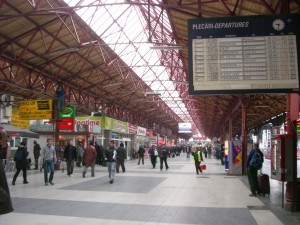Bucharest, Romania
Romania has around 22 million people which is the second biggest eastern european country just after Poland. Bucharest is a city of 2 million and is the capital.
I noticed that in Romanian there are some similar words to Spanish. Compared to some other languages with Latin roots (French, Spanish, Portuguese, Romanian..), the Romanian language is the closest to Latin.
Arrived in Bucharest at around 9.30am
![CIMG5523 [640x480] CIMG5523 [640x480]](http://journey26.com/blog/wp-content/uploads/2009/10/CIMG5523-640x480-300x225.jpg)
so the ride took around 11 hours. I got another couch here and my host is Aline. It’s very nice of her to come pick me up at the train station and my couch is actually in a dorm in a technical university.
main train station Gara de Nord

The city Bucharest looks a little torned, I am not sure what’s the word to describe it but it looks neglected like other ex-communist countries. There are some old and grey buildings.
![CIMG5528 [640x480] CIMG5528 [640x480]](http://journey26.com/blog/wp-content/uploads/2009/10/CIMG5528-640x480-300x225.jpg)
Wide street and junction, a legacy from the communist times
However, close to Piata Unirii, there are some nice historical buildings around the Parliament.
![CIMG5547 [640x480] CIMG5547 [640x480]](http://journey26.com/blog/wp-content/uploads/2009/10/CIMG5547-640x480-300x225.jpg)
Parliament Palace (the world’s second largest building after the US Pentagon) spans 12 stories, 3100 rooms and covers over 330,000 sq m.
A very good interactive site about the maps of buildings in Bucharest
Getting local food at Carefour because of the varieties and it’s cheap
![CIMG5592 [640x480] CIMG5592 [640x480]](http://journey26.com/blog/wp-content/uploads/2009/10/CIMG5592-640x480-300x225.jpg)
With Aline’s friends (Lucia, Aline, Peter, Daniela, Mihail) in the dorm. They are very friendly and I had a great time with them.
![CIMG5599 [640x480] CIMG5599 [640x480]](http://journey26.com/blog/wp-content/uploads/2009/10/CIMG5599-640x480-300x225.jpg)
Visited the Peasant’s museum in the morning (1.5LEI). It’s a very interesting museum where different kinds of houses from different parts of Romania were bought to this site.
The Peasant’s museum
![CIMG5608 [640x480] CIMG5608 [640x480]](http://journey26.com/blog/wp-content/uploads/2009/10/CIMG5608-640x480-300x225.jpg)
![CIMG5617 [640x480] CIMG5617 [640x480]](http://journey26.com/blog/wp-content/uploads/2009/10/CIMG5617-640x480-300x225.jpg)
Since I have an interest in Chinese economy and Chinese businesses, I took metro to Obor and then took a tram to the northeast direction. Walked 5 minutes to the northeast side from the last stop, to Europa, sort of a chinese market for the retail side. Spoke with a Chinese shopowner
![CIMG5641 [640x480] CIMG5641 [640x480]](http://journey26.com/blog/wp-content/uploads/2009/10/CIMG5641-640x480-300x225.jpg)
and he moved to Romania 10 years ago. He mentioned that China is developing so fast and even though quality of life in his town QingTian (a small town of 400,000 people and 250,000 live in overseas) is better than in Romania now but it’s hard for him to move back because China is too competitive and it’s hard to start all over again. The economy crisis did affect business for this year. He has 2 children in China. His past time after work is to surf the internet and he would like to go back to China soon.
Like in other countries, Chinese usually keep to themselves and don’t assimilate well with the local society. This is a pity because most Chinese immigrants are not highly educated so it’s harder for them to communicate with the locals.
![CIMG5642 [640x480] CIMG5642 [640x480]](http://journey26.com/blog/wp-content/uploads/2009/10/CIMG5642-640x480-300x225.jpg)
Retail Side
![CIMG5648 [640x480] CIMG5648 [640x480]](http://journey26.com/blog/wp-content/uploads/2009/10/CIMG5648-640x480-300x225.jpg)
Unlike in Budapest where there Chinese restaurants are everywhere, I don’t see a lot here in Romania. Walking in the city I didn’t really see any trace of Chinese businesses until I went to the market.
Wholesale side
This is just Dragonul building 2, there are Dragonul 1 to 7 so the market is huge. The complex sells pretty much everything in bulks.
Inside
![CIMG5663 [640x480] CIMG5663 [640x480]](http://journey26.com/blog/wp-content/uploads/2009/10/CIMG5663-640x480-225x300.jpg)
Food court selling chinese food
![CIMG5664 [640x480] CIMG5664 [640x480]](http://journey26.com/blog/wp-content/uploads/2009/10/CIMG5664-640x480-300x225.jpg)
I thought the Chinese market in Budapest is huge, but this is even bigger. The wholesale stores are behind the retail market and the whole area is around 2kmX2km.
After visiting a few Chinese market, I am amazed by the magnitude of Chinese businesses. This does not sound like Communism and those guys mean business, this is why China has a huge trade surplus.
Visited a Romanian market at Carigasi
![CIMG5679 [640x480] CIMG5679 [640x480]](http://journey26.com/blog/wp-content/uploads/2009/10/CIMG5679-640x480-300x225.jpg)
Took an overnight train to Sofia, Bulgaria at 8.04pm (130 LEI ~ 30 Euro)
![CIMG5685 [640x480] CIMG5685 [640x480]](http://journey26.com/blog/wp-content/uploads/2009/10/CIMG5685-640x480-225x300.jpg)
![CIMG5541 [640x480] CIMG5541 [640x480]](http://journey26.com/blog/wp-content/uploads/2009/10/CIMG5541-640x480-300x225.jpg)
![CIMG5561 [640x480] CIMG5561 [640x480]](http://journey26.com/blog/wp-content/uploads/2009/10/CIMG5561-640x480-300x225.jpg)
![CIMG5563 [640x480] CIMG5563 [640x480]](http://journey26.com/blog/wp-content/uploads/2009/10/CIMG5563-640x480-300x225.jpg)
![CIMG5577 [640x480] CIMG5577 [640x480]](http://journey26.com/blog/wp-content/uploads/2009/10/CIMG5577-640x480-300x225.jpg)
![CIMG5579 [640x480] CIMG5579 [640x480]](http://journey26.com/blog/wp-content/uploads/2009/10/CIMG5579-640x480-300x225.jpg)
![CIMG5607 [640x480] CIMG5607 [640x480]](http://journey26.com/blog/wp-content/uploads/2009/10/CIMG5607-640x480-300x225.jpg)
![CIMG5622 [640x480] CIMG5622 [640x480]](http://journey26.com/blog/wp-content/uploads/2009/10/CIMG5622-640x480-300x225.jpg)
![CIMG5624 [640x480] CIMG5624 [640x480]](http://journey26.com/blog/wp-content/uploads/2009/10/CIMG5624-640x480-300x225.jpg)
![CIMG5498 [640x480] CIMG5498 [640x480]](http://journey26.com/blog/wp-content/uploads/2009/10/CIMG5498-640x480-300x225.jpg)
![CIMG5502 [640x480] CIMG5502 [640x480]](http://journey26.com/blog/wp-content/uploads/2009/10/CIMG5502-640x480-300x225.jpg)
![CIMG5505 [640x480] CIMG5505 [640x480]](http://journey26.com/blog/wp-content/uploads/2009/10/CIMG5505-640x480-300x225.jpg)
![CIMG5506 [640x480] CIMG5506 [640x480]](http://journey26.com/blog/wp-content/uploads/2009/10/CIMG5506-640x480-300x225.jpg)
![CIMG5509 [640x480] CIMG5509 [640x480]](http://journey26.com/blog/wp-content/uploads/2009/10/CIMG5509-640x480-300x225.jpg)
![CIMG5512 [640x480] CIMG5512 [640x480]](http://journey26.com/blog/wp-content/uploads/2009/10/CIMG5512-640x480-300x225.jpg)
![CIMG5517 [640x480] CIMG5517 [640x480]](http://journey26.com/blog/wp-content/uploads/2009/10/CIMG5517-640x480-300x225.jpg)
![CIMG5519 [640x480] CIMG5519 [640x480]](http://journey26.com/blog/wp-content/uploads/2009/10/CIMG5519-640x480-300x225.jpg)
![CIMG5425 [640x480] CIMG5425 [640x480]](http://journey26.com/blog/wp-content/uploads/2009/10/CIMG5425-640x480-225x300.jpg)
![CIMG5427 [640x480] CIMG5427 [640x480]](http://journey26.com/blog/wp-content/uploads/2009/10/CIMG5427-640x480-225x300.jpg)
![CIMG5430 [640x480] CIMG5430 [640x480]](http://journey26.com/blog/wp-content/uploads/2009/10/CIMG5430-640x480-300x225.jpg)
![CIMG5438 [640x480] CIMG5438 [640x480]](http://journey26.com/blog/wp-content/uploads/2009/10/CIMG5438-640x480-300x225.jpg)
![CIMG5445 [640x480] CIMG5445 [640x480]](http://journey26.com/blog/wp-content/uploads/2009/10/CIMG5445-640x480-225x300.jpg)
![CIMG5448 [640x480] CIMG5448 [640x480]](http://journey26.com/blog/wp-content/uploads/2009/10/CIMG5448-640x480-300x225.jpg)
![CIMG5449 [640x480] CIMG5449 [640x480]](http://journey26.com/blog/wp-content/uploads/2009/10/CIMG5449-640x480-300x225.jpg)
![CIMG5451 [640x480] CIMG5451 [640x480]](http://journey26.com/blog/wp-content/uploads/2009/10/CIMG5451-640x480-300x225.jpg)
![CIMG5456 [640x480] CIMG5456 [640x480]](http://journey26.com/blog/wp-content/uploads/2009/10/CIMG5456-640x480-300x225.jpg)
![CIMG5474 [640x480] CIMG5474 [640x480]](http://journey26.com/blog/wp-content/uploads/2009/10/CIMG5474-640x480-300x225.jpg)
![CIMG5476 [640x480] CIMG5476 [640x480]](http://journey26.com/blog/wp-content/uploads/2009/10/CIMG5476-640x480-300x225.jpg)
![CIMG5481 [640x480] CIMG5481 [640x480]](http://journey26.com/blog/wp-content/uploads/2009/10/CIMG5481-640x480-300x225.jpg)
![CIMG5484 [640x480] CIMG5484 [640x480]](http://journey26.com/blog/wp-content/uploads/2009/10/CIMG5484-640x480-300x225.jpg)
![CIMG5486 [640x480] CIMG5486 [640x480]](http://journey26.com/blog/wp-content/uploads/2009/10/CIMG5486-640x480-300x225.jpg)
![CIMG5487 [640x480] CIMG5487 [640x480]](http://journey26.com/blog/wp-content/uploads/2009/10/CIMG5487-640x480-300x225.jpg)